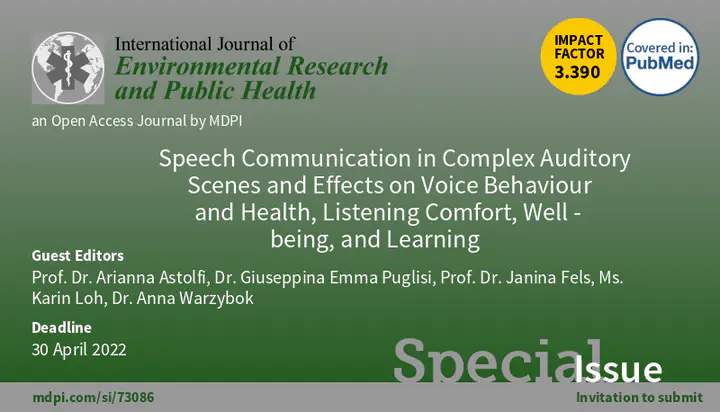Special Issue - Speech Communication in Complex Auditory Scenes and Effects on Voice Behaviour and Health, Listening Comfort, Well-being, and Learning

Abstract
We are immersed in multicultural and densely occupied settings that make everyday life environments more and more challenging from the acoustic point of view. Effective speech communication is a fundamental need to face everyday relationships during an entire lifespan. Especially, it is crucial to enhance learning, the sense of belonging to a group, the personal safety and satisfaction, the ability of understanding speech for people with hearing loss (e.g., with hearing aids or cochlear implants)and for people who speak a different language. Speech communication accounts for both a talker’s and a listener’s premises. On the one side, the talker is asked to preserve her/his voice, and on the other side, the listener must be enabled to understand a message clearly.
Unfavorable room acoustics, such as high reverberation as well as environmental and anthropically-generated noise are factors that affect speech communication and in turn health, listening comfort, learning, well-being and working productivity. Complex auditory scenes for speech communication can be referred among others to teaching and learning environments, offices, restaurants, social or recreation spaces, outdoor spaces, enclosed public transport premises, shopping malls.
Professionals, such as teachers, singers, call-centre operators, use their voice as a primary working tool and may suffer from the onset of vocal pathologies at several levels. Voice disorders and vocal load can increase due to recurrent situations, such as the acoustic characteristics of the environments in which voice is used.
Vulnerable listeners are particularly interested in enhanced auditory conditions, such as young pupils that are at the first stages of education, knowledge workers in big open-plan offices, the elderly who may suffer from hearing and cognitive deficits, and hearing-impaired listeners equipped with implants or hearing aids.
The aim of the present Special Issue is to bring together up-to-date research on the speaking- and auditory-related aspects of speech communication in everyday life environments, such as:
Experimental campaigns to investigate complex auditory scenes for speech communication;
Application of virtual reality to investigate complex auditory scenes;
Optimization of auditory scenes;
Flexible solutions in everyday life environments to improve speech communication;
Control of speech and noise generated by occupants;
Assessment of the perceived acoustic comfort and well-being via occupant survey and relations with acoustic measurement data;
Occupants’ health in dependence on acoustic conditions;
Occupants’ cognitive abilities, performance and productivity related to their acoustic environment;
Impact of hearing impairment and benefit from hearing devices;
Influence of other environmental aspects on speech communication.